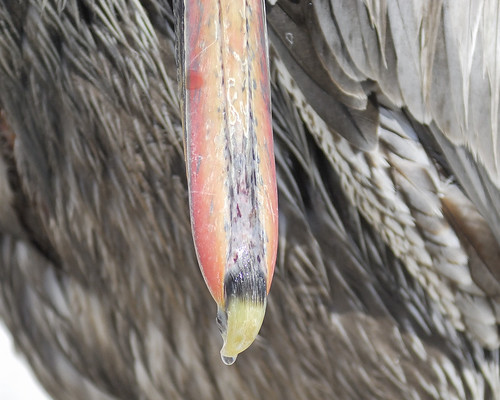tags: Brown Pelican, Pelecanus occidentalis, birds, mystery bird, bird ID quiz
[Mystery bird] Brown Pelican, Pelecanus occidentalis, photographed at Monterey Bay, California. [I will identify this bird for you in 48 hours]
Image: Joseph Kennedy, 7 May 2010 [larger view].
Nikon D200, Kowa 883 telescope with TSN-PZ camera eyepiece 1/750s f/8.0 at 1000.0mm iso400.
Please name at least one field mark that supports your identification.
Can you tell me something remarkable about this mystery bird's beak/mouth?
The pelican's gullet pouch really can "hold more than its belly can" (as claimed by a well-known poem). The bird's pouch holds up to 2½ gallons, the stomach only about one gallon.


It's so nice to see one of these guys that isn't dripping oil, GrrlScientist. D.L. Merritt knew some interesting things about this bird's beak/mouth.
My first thought was "Frigate Bird" then I saw the mass and heft of this large, large bill -- it's a bird too much in the news these days, sad to say: the Brown Pelican. This bird's bill has several marvelous attributes; most famous is the expansive gular ), which the bird uses as a fishing net (not to carry fish; it swallows the fish whole, even when they are oil-soaked...). The pelican's pouch is also useful in attracting a mate (doesn't do much for me) and as a cooling device (the bird opens the bill and flaps the wet skin of the pouch, thus cooling by evaporation). Another neat feature, common to many seabirds, and (I think) pictured here, is the presence of "salt glands" which enable the bird to ingest salt water and excrete the excess salt in briny droplets such as shown in the photo. Field marks: Massive bicolored bill with strongly hooked tip, brown-grey plumage, and that briny drop! They are very beautiful birds and (as all creatures are) fascinating.
Sorry -- that garbled sentence should read as follows:
This bird's bill has several marvelous attributes; most famous is the expansive gular pouch (the Frigate Bird also has it), which the bird uses as a fishing net ...
Quite an interesting shot. Photos nearly always show the beak in profile so this makes a change.
I wasn't aware that pelicans had salt glands -- I had thought that those were limited to the Procellariformes. If they are found in pelicans, they would be up near the base of the bill, emptying into the nostrils.
pelicans do indeed have salt glands, as do gulls.
This is the largest bird species I've personally seen, larger than the bald eagles I've spotted. Witnessing them for the first time was like seeing pterosaurs - freakin' awesome. I saw a lone feather on that beach too, really long with narrow vanes. Inspiring.
-